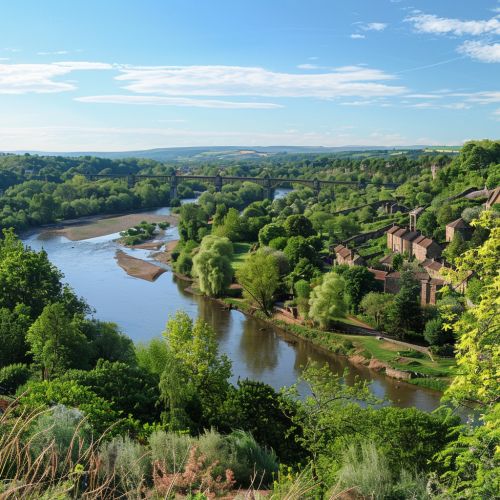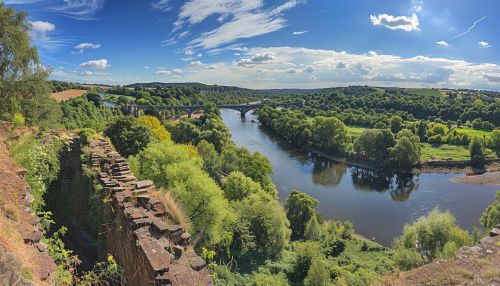Ironbridge Gorge
History
The Ironbridge Gorge is a deep gorge formed by the River Severn in Shropshire, England. The gorge was first formed during the last ice age when the river carved a path through the surrounding rock. The area has a rich history dating back to the Roman era, with evidence of early industry and settlement. However, it was during the Industrial Revolution that the gorge truly came into prominence.


The name 'Ironbridge Gorge' is derived from the famous Iron Bridge that spans the gorge. Built in 1779, the Iron Bridge was the first arch bridge in the world to be made of cast iron. The bridge was a significant achievement in engineering and marked a turning point in the use of iron for large-scale structures. The bridge was designed by Thomas Farnolls Pritchard and built by Abraham Darby III, both of whom were pioneers in the use of iron. The bridge and the surrounding area became a symbol of the Industrial Revolution and the advancements in technology and engineering that it brought about.
Geology
The geology of Ironbridge Gorge is complex and varied, with a range of rock types present. The gorge is primarily composed of sedimentary rocks, including sandstone, limestone, and shale. These rocks were formed over millions of years from layers of sediment deposited by ancient rivers and seas. The gorge also contains significant deposits of coal, iron ore, and clay, which were key resources during the Industrial Revolution.
The gorge's unique geology has played a significant role in its history. The presence of coal and iron ore led to the development of the iron industry in the area, while the clay deposits supported a thriving pottery industry. The geology of the gorge has also influenced its landscape, with the steep sides of the gorge providing a dramatic backdrop to the industrial sites.
Industrial Heritage
Ironbridge Gorge is often referred to as the birthplace of the Industrial Revolution. The area was home to a number of important industrial developments, including the first successful smelting of iron with coke by Abraham Darby I in 1709. This process, known as the coke-firing method, revolutionized the iron industry and paved the way for the large-scale production of iron.
In addition to iron production, the gorge was also a center for other industries. The area was known for its pottery, with several factories producing high-quality earthenware and china. The gorge was also home to a number of coal mines, which provided the fuel for the iron and pottery industries.
The industrial sites of Ironbridge Gorge are now preserved as part of the Ironbridge Gorge Museums, a collection of museums and historic sites that tell the story of the Industrial Revolution. The museums include the Iron Bridge and Tollhouse, the Museum of the Gorge, the Coalbrookdale Museum of Iron, and the Jackfield Tile Museum, among others.
Conservation and Tourism
Today, Ironbridge Gorge is a major tourist destination, attracting visitors from around the world. The area is recognized for its industrial heritage and its beautiful natural scenery. In 1986, Ironbridge Gorge was designated a UNESCO World Heritage Site, in recognition of its significant contribution to the Industrial Revolution and its impact on world history.
Conservation efforts in the gorge are focused on preserving the industrial sites and the natural environment. The Ironbridge Gorge Museums Trust is responsible for the management and conservation of the historic sites, while the Severn Gorge Countryside Trust manages the natural environment of the gorge.
